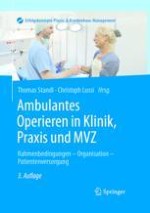2016 | OriginalPaper | Buchkapitel
16. Anästhesiologische Aspekte
verfasst von : W. Wilhelm, A. Herminghaus, T. Standl, S. Eibicht, S. Rapp, A. Gottschalk
Erschienen in: Ambulantes Operieren in Klinik, Praxis und MVZ
Verlag: Springer Berlin Heidelberg











